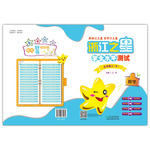题目内容
阅读理解。
John and Laura were husband and wife. Laura had beautiful, long brown hair, shining like the silk. Every
morning she combed her hair many times. John had a golden pocket watch (怀表) left by his father. He loved
it very much. Christmas was coming. The couple (夫妇) both wanted to send a gift to each other. John went
to the shop and found a nice comb. He thought Laura's hair would look prettier with the comb on it. But the
comb was so dear that he couldn't afford it (买不起). He thought and thought. At last, he sold his pocket
watch and bought the comb. When he got home, he was surprised to see Laura's short hair. Laura opened her
hands. There was a golden watch chain (金表链) in her hands. "Merry Christmas!" said Laura. John said
"Merry Christmas" too and passed his wife a little box with tears in his eyes. Laura opened it…
morning she combed her hair many times. John had a golden pocket watch (怀表) left by his father. He loved
it very much. Christmas was coming. The couple (夫妇) both wanted to send a gift to each other. John went
to the shop and found a nice comb. He thought Laura's hair would look prettier with the comb on it. But the
comb was so dear that he couldn't afford it (买不起). He thought and thought. At last, he sold his pocket
watch and bought the comb. When he got home, he was surprised to see Laura's short hair. Laura opened her
hands. There was a golden watch chain (金表链) in her hands. "Merry Christmas!" said Laura. John said
"Merry Christmas" too and passed his wife a little box with tears in his eyes. Laura opened it…
1. John and Laura were _____.
[ ]
A. rich
B. poor
C. not happy
D. hungry
B. poor
C. not happy
D. hungry
2. How did Laura buy the golden chain?
[ ]
A. She worked hard
B. She borrowed some money
C. She sold her long hair
C. She sold their house
B. She borrowed some money
C. She sold her long hair
C. She sold their house
3. Why did John sell his pocket watch?
[ ]
A. Because he loved Laura
B. Because it was Christmas
C. Because he had little money
D. All of the above
B. Because it was Christmas
C. Because he had little money
D. All of the above
4. What was in John's little box?
[ ]
A. A new watch
B. A new dress
C. A new comb
C. A turkey
B. A new dress
C. A new comb
C. A turkey
5. What can you learn from this story?
[ ]
A. On Christmas you must give dear gifts to your friends.
B. You have to get more money.
C. You mustn't buy useless (没用的) things.
D. A friend in need is a friend indeed.
B. You have to get more money.
C. You mustn't buy useless (没用的) things.
D. A friend in need is a friend indeed.
1-5: BCDCD

练习册系列答案
 一课一练一本通系列答案
一课一练一本通系列答案 浙江之星学业水平测试系列答案
浙江之星学业水平测试系列答案 高效智能课时作业系列答案
高效智能课时作业系列答案
相关题目
| 阅读理解。 | ||||||||
| ||||||||
| 1. If you are interested in folk music, yon might choose the book _______. | ||||||||
| A. The Snowman B. Madame Bovary C. Electric Eden D. Between Shades of Gray | ||||||||
| 2. The Snowman most probably tells _______. | ||||||||
| A. a life story B. a disaster story C. a love story D. a detective story | ||||||||
| 3. We can infer (推荐) that all the books above are _______. | ||||||||
| A. available B. for adults C. expensive D. newly written |



